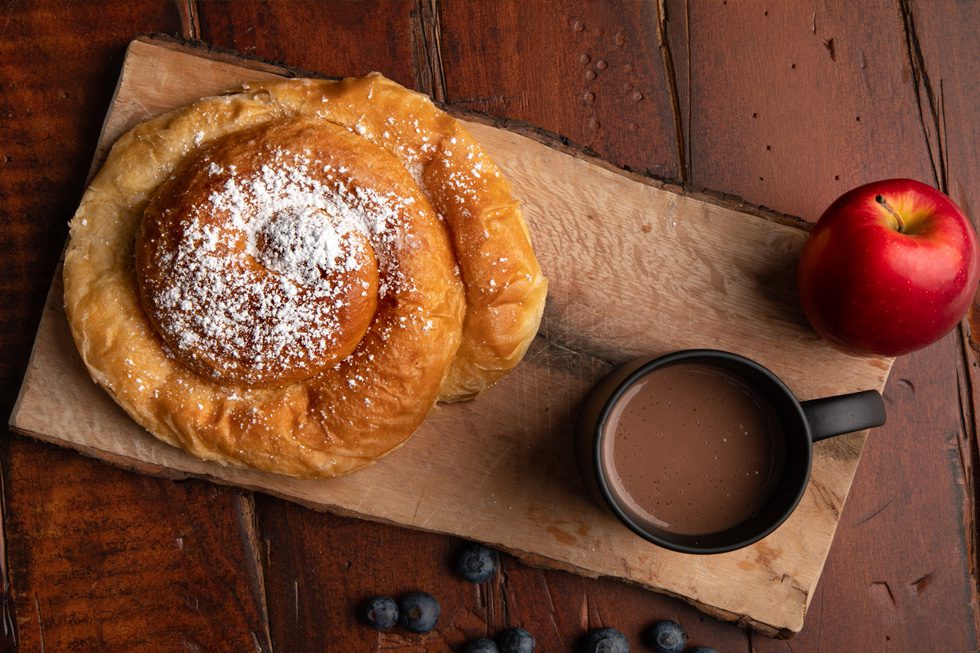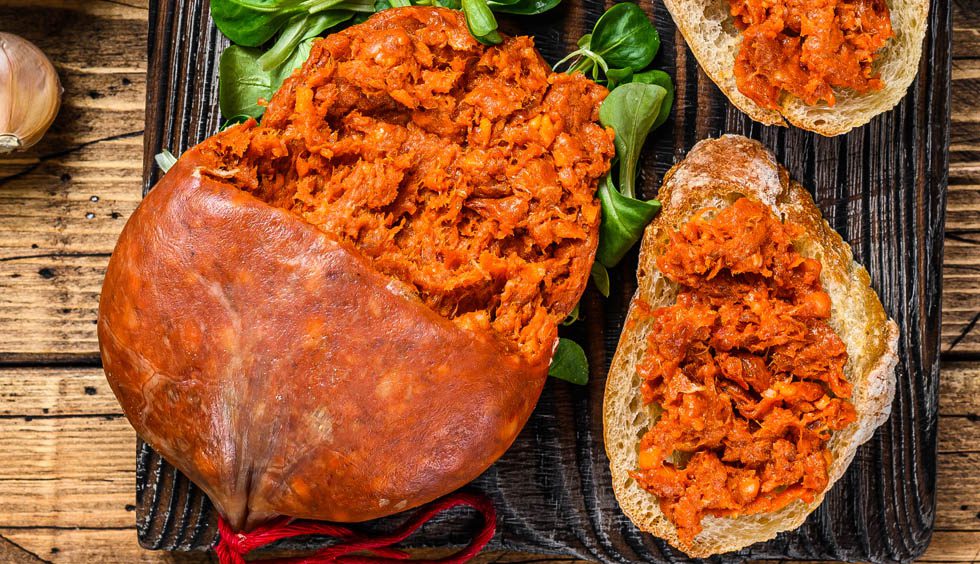How many reasons can you think of to visit Menorca? The truth is that there are many, since Menorca is for many, one of the best islands of the Balearic archipelago, if not the best. Not for nothing is it a UNESCO Biosphere Reserve. But beyond its impressive coves and unspoiled landscapes, the island is also an epicenter of tradition, where the local gastronomy reflects centuries of history, cultural influences and the love for fresh and local products. Menorca’s typical dishes tell a story, a culinary heritage passed down from generation to generation. In this post, we invite you to embark on a delicious journey through the most authentic flavors of Menorca. You will discover the typical dishes you must try during your visit and, most importantly, we will reveal the best places on the island where you can enjoy them.
Get ready to savor Menorca!
Typical dishes of Menorca
These are some of the typical dishes of Menorca that you cannot miss in your culinary trip:
Caldereta de Langosta, the king dish of Menorca.
The Caldereta de Langosta is, without a doubt, the most emblematic dish of Menorca and a delicacy that every visitor must try. This succulent lobster soup, simmered with a base of tomato, peppers, onion, garlic and parsley, captures the essence of the Mediterranean Sea in every spoonful. Its origins date back to the island’s ancient fishing traditions, where fishermen used the freshest ingredients available to create a stew that would warm the body and soul after long days at sea. Today, Caldereta de Langosta is a symbol of Menorca’s gastronomic richness, served in the best restaurants and appreciated by locals and tourists alike.
Sobrasada menorquina, the Mediterranean sausage
Sobrasada Menorquina is a local variant of this famous Balearic sausage, known for its milder flavor and creamy texture. Made from pork, paprika, salt and spices, sobrassada is a product that is cured in the air, acquiring a unique flavor thanks to the climate and the Menorcan tradition. It is consumed both raw, spread on bread, and cooked in various dishes, adding a touch of flavor to soups, rice and other stews. In Menorca, sobrassada is much more than a sausage; it is an integral part of the local gastronomic culture, reflecting the connection between Menorcans and their land.
Oliaigua, the essence of the most humble traditional cooking
Oliaigua is a humble but deeply rooted dish in Menorca’s culinary tradition. Originally a peasant meal, this simple stew is prepared with olive oil, water, tomatoes, peppers and stale bread, often enriched with some seasonal vegetables. Oliaigua is a clear example of Menorcan cuisine’s ability to transform simple ingredients into a comforting dish full of flavor. Although it may seem simple, its preparation requires skill to balance the flavors and achieve a perfect consistency. This dish is a window into the daily life of Menorca in times gone by and is still highly prized for its authenticity.
Mahon cheese, the unique taste of tradition
Mahón-Menorca cheese is another of the island’s culinary treasures. This cheese with Protected Designation of Origin (PDO) is made from cow’s milk, although there are also mixed varieties that include sheep’s or goat’s milk. The production process is artisanal, following traditional methods that include curdling, pressing and maturing in special cellars. Depending on the ripening time, the cheese can be soft, semi-cured or cured, offering a range of flavors from mild and creamy to more intense and spicy. Its characteristic orange rind, the result of rubbing with olive oil and paprika, and its unmistakable flavor, have made Mahón-Menorca cheese an ambassador of the island in the world.
Local meats and fish
The richness of Menorca’s sea and land is reflected in its local meat and fish dishes, which vary according to season and tradition. In the Mediterranean swim red mullet, mullet, sole, grouper, sea bream, sea bream, squid, sea bass, monkfish, conger eels… and the island’s traditional cuisine has always been linked to these delicacies found by the ancient fishermen. A large part of Menorcan seafood recipes have their origin in the simple cooking on board the fishing boats. There are several traditional dishes, one of the best known being baked skate; the bandeja de raons; arroz caldoso, made with fresh seafood, is a favorite or fish a la menorquina, a dish in which the fish is slowly cooked with potatoes, tomato, peppers and wine, infused with Mediterranean herbs. As for meats, Menorcan lamb, baked in the oven with local spices, is a sample of the fusion of flavors that characterizes the island’s cuisine.
Typical pastries
No gastronomic trip to Menorca would be complete without tasting its traditional pastries. The Menorcan ensaimada is the jewel, a special version of this famous Balearic pastry, which in Menorca is made with a unique touch, often filled with angel hair or sobrasada. These desserts are not only a pleasure for the palate, but also a way to savor the history and traditions that have been so lovingly preserved on the island. Another of the most emblematic sweets is the carquinyol, a small almond sponge cake, crunchy on the outside and tender on the inside, which is usually accompanied with a coffee or a glass of local liqueur. But to say Menorca is also to say rubiols, crespells, coca, congret, panet de mort. The recipes used to be prepared following the calendar of festivities: greixeres at Carnival, formatjades at Easter, ensaimadas with hot chocolate at the summer festivities, buñuelos at All Saints or tortada, turrones and cuscussó at Christmas. And of course pastissets for family celebrations.
Where to eat in Menorca
Lobster stew in Fornells
One of the best places to try the caldereta de langosta in Menorca is Fornells, a small fishing village on the north coast of the island, it belongs to the area of es Mercadal. Fornells is famous for its spectacular coastline, which can be visited by boat with skipper, for its fish and fishermen culture, for its manzanilla and of course for its caldereta de langosta (lobster stew). There are many restaurants that offer lobster stew, but three of the ones we like the most are Es Cranc, Sa Llagosta and Es Cranc Pelut.
Minorcan Sobrasada from Binigarba, in Ciutadella
Binigarba is a farm located in Ciutadella. The farm is dedicated to the production of cheese and also has a farm of mother sows, which are fed with the products of the farm, and part of the production is destined to typical handmade sausages. If you are a sausage lover you must try and enjoy the Sobrasada de Cerdo Negro de Payés de Binigarba. A curious place to go for breakfast if you are staying in Mahón is Es Llonguet. It is an artisan oven where you can start the day with a typical breakfast. They have pastries, ensaimadas and if you are a salty person, you have to ask for a llonguet of sobrasada. You will like it so much that you will surely take home something under your arm!
Oliaigua, in any restaurant in Menorca
This soup can be tasted in almost any restaurant in Menorca, even in pizzerias!
Mahon cheese
The vast majority of the island’s restaurants, bars and cafés have this delicious cheese on their menus. But if you are a cheese lover, a great plan is to do a cheese tasting in one of the traditional cheese dairies of the island. For example Torretrencadeta, Lligam des Fogasse where you can also taste wine and sausages, Queseria Lluriach in Es Mercadal, Son Piris or Sa Roqueta.
Consejos para disfrutar de la gastronomía menorquina
Menorca’s gastronomy is a reflection of the cycle of nature, and there are times of the year that stand out especially for the richness of the products available and the culinary events that are held. Spring and summer are the ideal times to visit the island if you want to enjoy the freshness of local seafood and fish, such as the famous Caldereta de Langosta (lobster stew). These months are also perfect for tasting seasonal fruits and vegetables that are incorporated into dishes such as Oliaigua. In addition, in June, Menorca celebrates the Festival of Sant Joan in Ciutadella, a cultural and gastronomic event where you can taste local products in a festive atmosphere. If you prefer to avoid the crowds, autumn is another excellent option, as temperatures are still pleasant and it is the olive harvesting season, which will allow you to taste fresh oils and cured cheeses, as well as enjoy quieter events related to gastronomy.
For true food lovers, Menorca offers a variety of gastronomic experiences that go beyond simply sampling dishes in a restaurant. A guided gastronomic tour is a great way to learn about the island’s history and culinary culture, with stops at local markets, traditional bakeries and restaurants offering the best examples of Menorcan cuisine. Visits to wineries or signing up for a traditional Menorcan cooking workshop are other great ways to take home a little piece of Menorca’s culinary culture. With all these experiences we guarantee that you will connect deeply with the essence of Menorca, creating memories that will last long after you return home. If you are looking for more things to do in the Balearic Islands do not miss:
- The 7 most beautiful coves in Mallorca and their services.
- From Majorca to Menorca by boat: an unforgettable crossing
